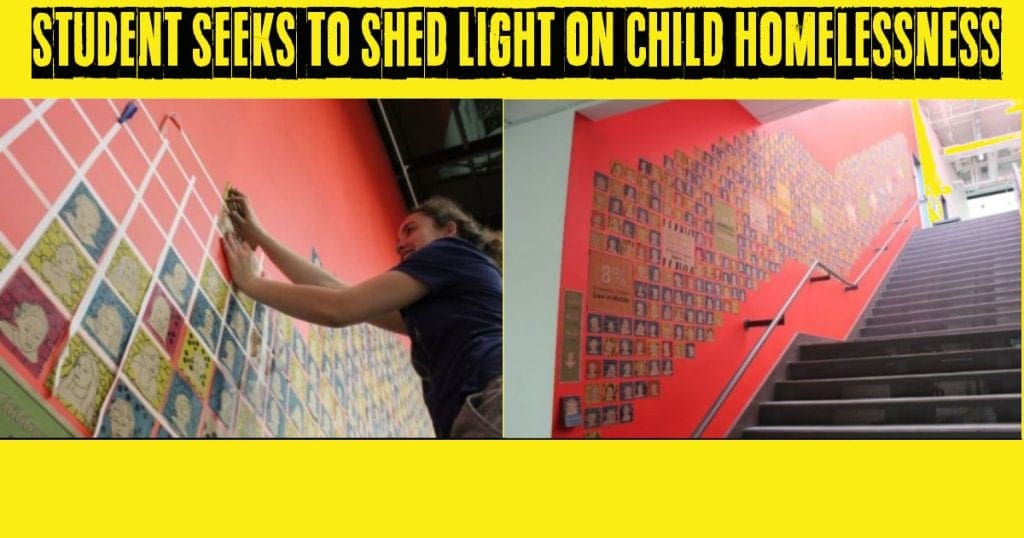“We wanted to do something that youth and young adults could get involved in, so me and my brothers and a bunch of my friends started our own group of St. Vincent de Paul.”

Kat Brissette wanted to use her art project to bring awareness to the homeless community in Rhode Island, and she found a vibrant way to do it.
Brissette, a junior at Rhode Island College, used the main stairwell at Alex and Ani Hall as her canvas to shed light on the homeless problem in the state, namely the children affected. Her final product depicts an ascending collection of children’s faces surrounding statistics on homeless youth, including that 1,031 Rhode Island children are homeless and that 8 percent of those kids reside in motels. Children account for 25 percent of the state’s homeless population.
“I was aware of the growing number of homeless people, especially homeless children,” Brissette said. “I wanted to do a project involved in giving back to the community and bringing awareness to a growing number of Rhode Islanders that were neglected.”
As a graphic design major, Brissette was looking to extend outside of the usual books or posters and create something “interactive.” The writing was on the wall.
“I chose to do it on the main stairwell in the art building [because] it’s a large wall so you can’t really miss it,” Brissette said. “I had a cool idea to do it there. It is also similar to what a wall might be in other public spaces so the idea was to come up with an installation that could be installed in various different environments.”
Brissette’s recently completed assignment, which was part of her BFA program, wasn’t her first foray into helping those in need. She frequently volunteers at St. Vincent de Paul and helped create a group called NextGen.
NextGen is designed to bring young adults together to work on projects of their own, and Brissette helped assemble it. An example of the work they do is a program called “Necessities for Neighbors,” which provides essentials to those with no means to purchase them.
“We put toiletries in bags then distribute them to food kitchens, homeless shelters and people on the streets,” Brissette said. “We do toiletry drives, we sort them and make care packages and a personal note and deliver them to the homeless and other people living in poverty.
“We wanted to do something that youth and young adults could get involved in, so me and my brothers and a bunch of my friends started our own group of St. Vincent de Paul.”
Brissette also offered her take on the controversial public safety ordinance in Cranston that prevents solicitation on roadways, otherwise referred to as the “panhandling ordinance.”
“No person shall stand in or enter upon a roadway for the purpose of distributing anything to the occupant of any vehicle or for the purpose of receiving anything from the occupant of any vehicle,” reads the city’s ordinance.
Brissette said it’s a “tricky” proposition. According to her, those who are homeless are more concerned with finding shelter or employment rather than earning money on a corner or median strip.
“I don’t think that [panhandling] is a big way to try to get money and I feel like most of the people on the street corner, most of them are homeless but people really in bad situations are more about trying to find a place to stay,” Brissette said. “They don’t want to stand in front of people trying to get money, a lot of them are trying to get jobs or a way through. A lot of times a mother who has kids that are homeless is more concerned with trying to find a place rather than standing on a street corner.”
Brissette said she encountered disbelief when she would tell others the figure of more than 1,000 homeless children in Rhode Island, as most of these kids are not out in plain sight. A majority are enrolled in school trying to get by in shelters or motels.
She hopes her project can continue to help a growing portion of the population that needs as much assistance as possible. Breaking the stigma is another goal of hers.
“There’s also a growing amount of abuse in families, there’s a lot of people who can’t afford to live any longer and people ignore that population because they have an idea in their head of who or what a homeless person is,” Brissette said. “A family or child who’s homeless, they’re able to hide it a little or they try to hide it a little more.”
Source: The Cranston Herald, Frederic’s E-gazette 5/25/17







0 Comments